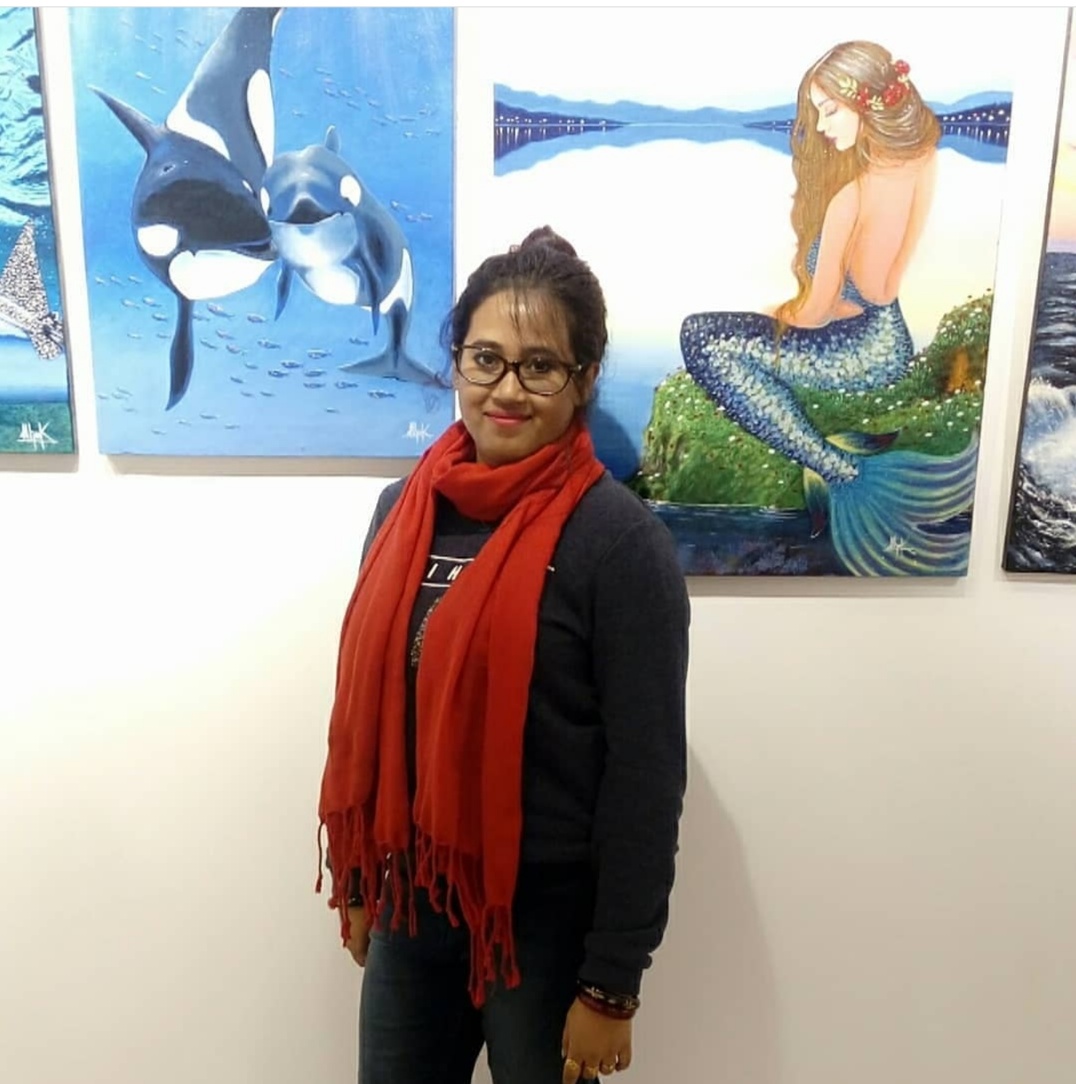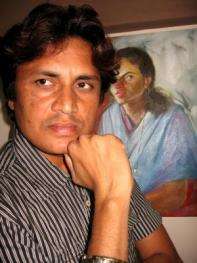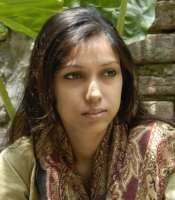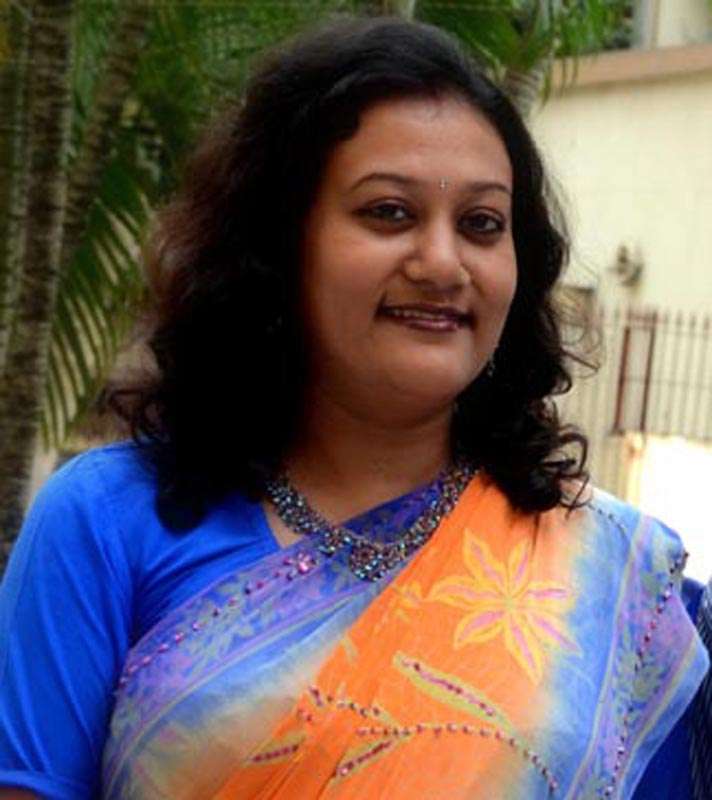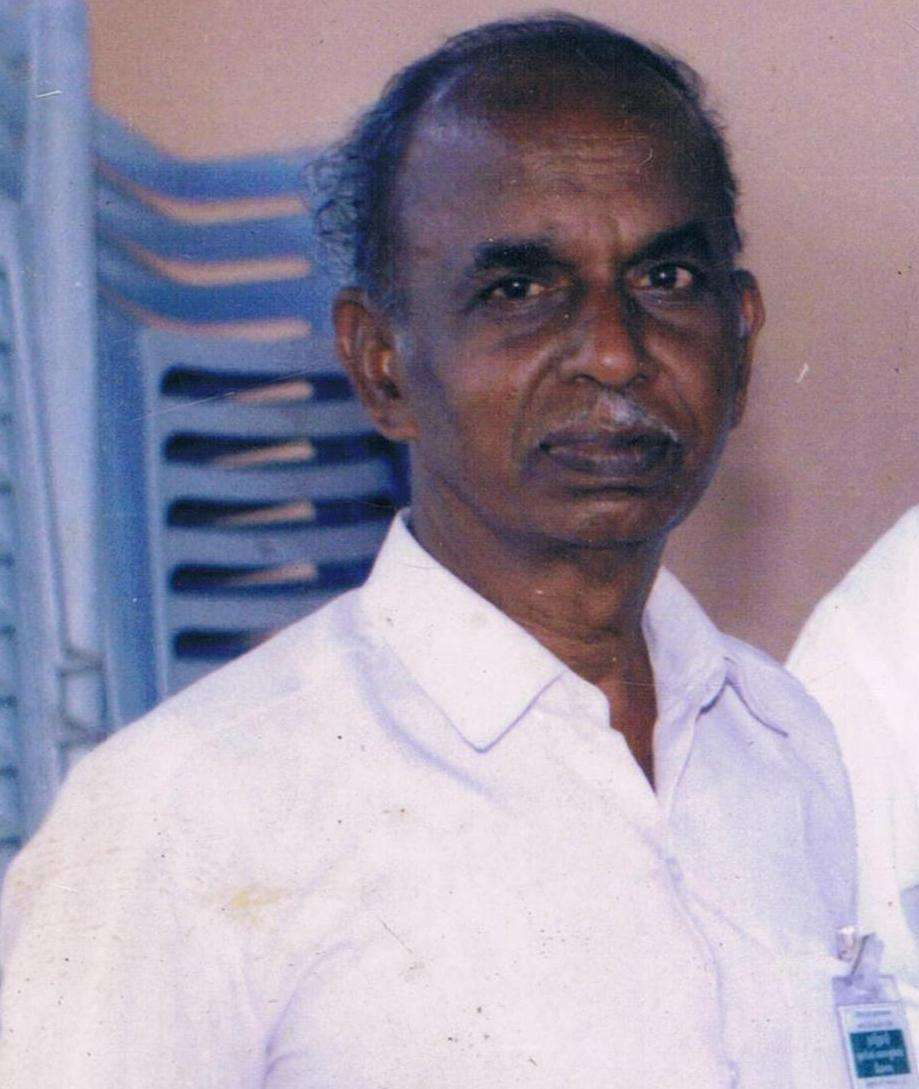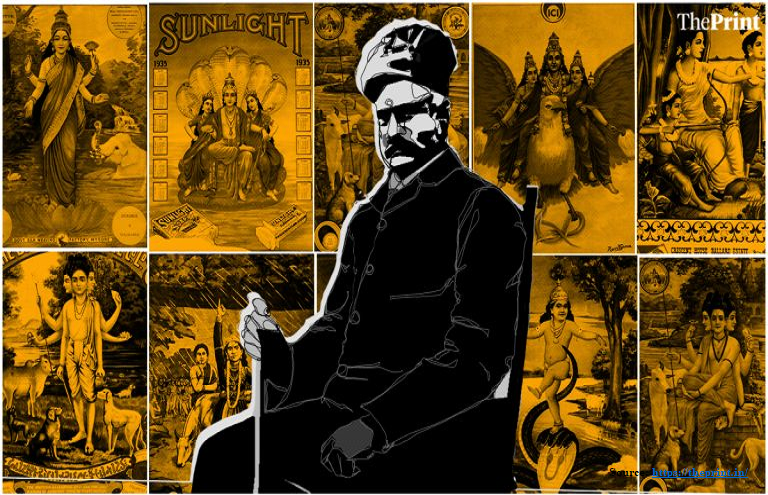
Initially, our gods looked different – their depictions in the ancient Indian paintings were inspired by the stone sculptures in the temples. Created similar to cave art, they did not look gracious and relatable.
It was in the 19th century that Raja Ravi Varma broke barriers bringing detail and realism to Indian imagery. Through a delicate interplay of light and shadows, he defined the images of our gods and goddess, with his most famous work being of ‘Lakshmi paintings.’
He used European realism and art techniques for depicting Indian gods and mythological characters, which gradually shaped Indian ‘calendar art’ and deeply influenced our literature as well as film industry. Prints in his distinctive style are still omnipresent as objects of worship across India.
Let’s explore the some of the stunning god paintings of this celebrated Indian painter and artist:
-
Lakshmi painting- ‘Sacred Goddess Of Wealth’
Considered as the bestower of power, wealth, luxury and sovereignty, Goddess Lakshmi is portrayed as a beautiful young woman with four hands standing on a blooming lotus flower. Draped in red saree with golden threads and bedecked with gold ornaments, she can be seen holding two lotuses in her hands and flanked by white elephants.
While the lotuses in the painting symbolises beauty, purity, karma, self realisation, and consciousness, the elephants represent strength, activity and hardwork. The water body in the background exemplifies prosperity.
Raja Ravi Varma’s Lakshmi painting is one of his magnificent creations which adorns most Hindu homes and offices.

-
Saraswati Painting- ‘Portrait of Goddess of Words’
Painted in 1896, the classic painting of Saraswati, Goddess of knowledge and wisdom is featured in line with the description of the goddess in the Holy scriptures.
Raja Ravi Varma portrays the deity as a beautiful woman in a white saree symbolising purity, with four hands- two holding a veena, representing perfection in arts and music, while a conch, and a rosary in the other two. Her mount, the peacock on her side symbolises beauty, creativity and truth.
Saraswati painting is iconic in its visualization all over the world and remains one of the most popular prints by Varma till today.
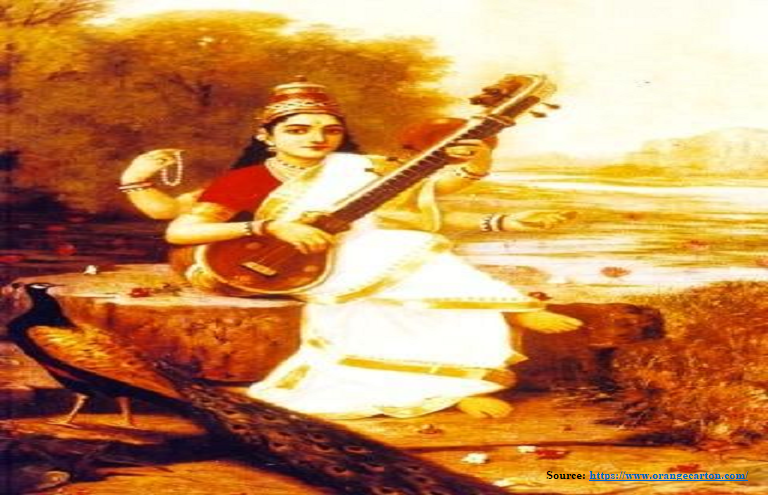
-
Descent of Ganga
Raja Ravi Varma has beautifully portrayed the story of Goddess Ganga’s descent from heaven on to earth. Fearing a catastrophe, Lord Shiva can be seen laying out his matted hair to hold the river as she descended. This manifestation of Shiva is known as Gangaadhara. While Goddess Parvati, sage Bhagiratha and Nandi are portrayed standing nearby.
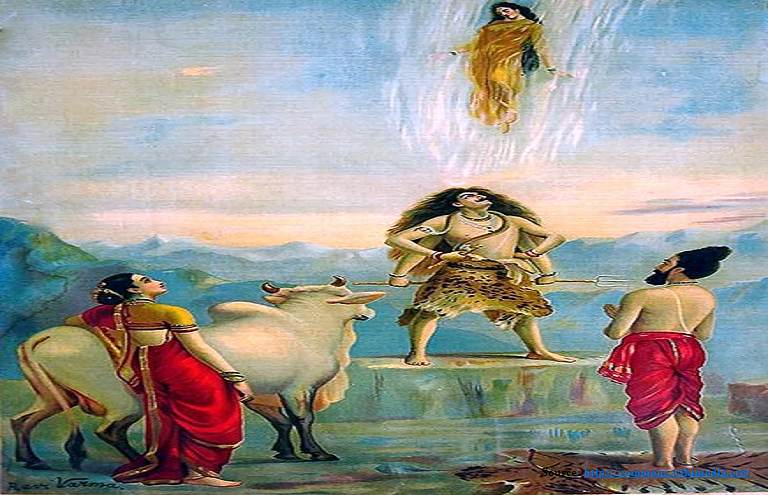
-
Lord Vishnu Painting & Consorts
Raja Ravi Varma portrays the supreme deity ‘Lord Vishnu’ with his consorts ‘Maya’ and ‘Lakshmi.’ They are featured sitting on the coiled throne built by the massive five headed snake ‘Shesha’ floating over the cosmic ocean of matter, space and time.
As per Hindu mythology, Lord Vishnu is considered the deity responsible for maintaining balance in the universe. He along with the five-headed Shesha control the time in the universe. The serpent’s long coiled tail represents the infiniteness of time.
In the painting, Lord Vishnu is holding four things in his hands – chakra, conch, lotus flower and a club. The chakra symbolises a purified spiritual mind while the lotus represents purity & abundance and authority & knowledge respectively.

-
Shiva Family
The supreme deity, Lord Shiva is portrayed with Goddess Parvati and Lord Ganesha sitting on a golden throne over the mountain ranges of Kailash in the beautiful painting by Raja Ravi Varma. Nandi is portrayed keeping guard in front of them.
Lord Shiva is depicted holding a ‘trishul’ and an ‘axe’. The trishul signifies the power of the deity as the creator, preserver and destroyer of things in the universe.
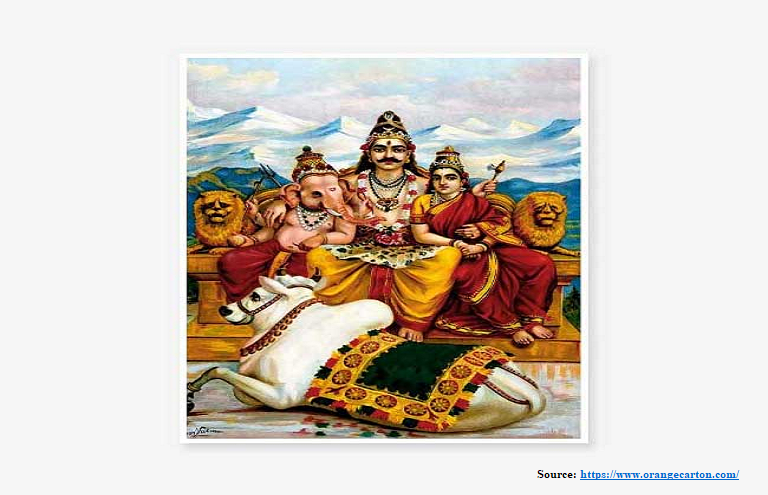
-
Goddess Kali
Embodying the shakti - feminine energy, creativity and fertility, Goddess Kali is an incarnation of Parvati, wife of the Lord Shiva.
Raja Ravi Varma has portrayed Kali, mysterious goddess of death, doomsday and destruction as a fearful figure engaged in the act of killing. Her protruding red tongue signals her thirst for blood as well the Bengali tradition of modesty. Her dishevelled hair signifies her unrestrained blood lust and alternatively the metaphysical mystery of death that encircles life. Her three eyes represent omniscience.
Depicted as a dark skinned woman, she can be seen wearing a necklace of severed heads and girdle of severed arms which signifies her killing rage but are also tantric metaphors for creative power and severance from the bonds of karma. The bloodied sword in her hands symbolises higher knowledge and the separated head with a skull cup to catch the blood signifies the importance of divine knowledge that detaches souls from the bondage of ignorance and ego.
She’s standing over Lord Shiva who is lying beneath in an attempt to calm her down.
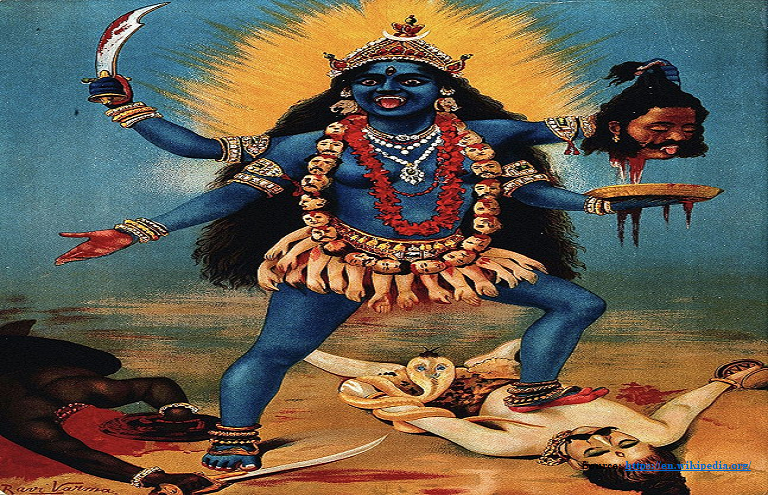
-
Vishnu on Garuda
This creation of Raja Ravi Varma portrays Lord Vishnu with his two wives, Lakshmi and Maya on his vehicle and ardent devotee, Garuda.
Considered the king of all birds, Garuda is the personification of courage, strength, speed, and of martial prowess.
In this painting, Garuda can be seen holding a snake in his hands which represents his fierce enemy, the ‘Nagas’ (snake). The snake is also a manifestation of evils in the world which Lord Vishnu with help of Garuda is trying to eradicate.

-
Sri Shanmukha Subramanya
In this colourful painting, Raja Ravi Varma has portrayed Lord Subramanya (also known as Kartikeya or Murugan) with his two wives ( Valli and Devasena). He is considered to be the first son of Shiva & Parvati and is a warrior and the leader of Lord Shiva’s army.
In this artwork, Lord Subramanya is depicted with six heads, twelve arms riding on his mount peacock along with his wives. The trio symbolises action, determination and knowledge wherein Devasena and Valli represent kriya shakti (the power of action) and Iccha-shakti (will-power) respectively, while Lord Shanmukha Subramanya represent the symbol of the transcendental jnana-shakti (the power of knowledge).
The peacock can be seen clutching a snake in its claws which represents human ego, indicating that it is essential to overcome ego to be successful and invincible.
He is often revered as the god of war and victory.
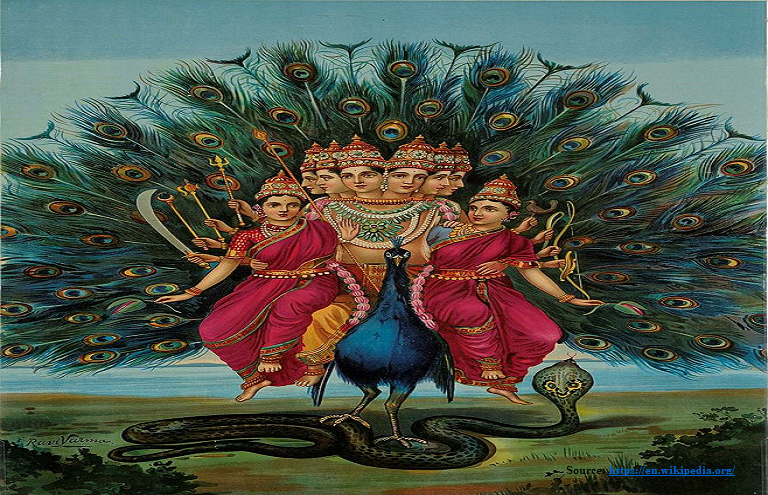
-
Matsya Avatar
Raja Ravi Varma depicts the first incarnation of Lord Vishnu on earth, Matsya in this artwork. It portrays the deity as half fish-human.
The upper half of Matsya avatar is human, while the lower part resembles that of a fish. Lord Vishnu is seen with four hands wherein he is holding chakra in one, conch in other while gripping children from drowning in the ocean with the other two hands.
The artwork symbolises Lord Vishnu as Matsya saving the religious texts, Vedas in the event of an ancient doomsday flood.
![]()
-
Dattatreya
Dattatreya, also referred to as Sri Datta, is a Hindu God who is also regarded as a manifestation of the Divine Trinity or Trimurti of Lord Brahma, Vishnu and Shiva. Derived from two Sanskrit words, Datta (which means given) and Atreya (which refers to the sage Atri, the biological father of Dattatreya).
Lord Dattatreya is worshipped to protect us from all evil influences and to lead a happy, prosperous and peaceful life.
In this painting, Raja Ravi Varma portrays Dattatreya as a yogi with three heads and six hands with each representing god from this Trimurti (Brahma, Vishnu, Shiva). The hands hold various symbolic items of each god. A pair of hands hold a chakra and conch of Lord Vishnu. Another pair carries a trishul and drum, the symbols of Lord Shiva. The other pair holds a lotus flower and a pot representing Lord Brahma.
A cow (representing Panchabhutas) and four dogs representing the inner forces of human beings- Iccha (desire), Vasana (passion), Asha (hope) and Trishna (thirst) can also be seen surrounding Dattatreya in the painting. Symbolising mother Earth and the four vedas respectively that nourishes all living elements on the planet.
The three heads and six hands have different interpretations as well. The three heads represent the ‘gunas’ (qualities) each human should possess – Sattva (goodness, positivity, truth), Rajas (passion and activity) and Tamas (destruction, chaos). Alternatively, the six hands stand for the six goals of human life – Yamas (self control), Niyama (positive duties), Samatva (equality), Dama (moderation), Daya (empathy) and Shanti (peacefulness).
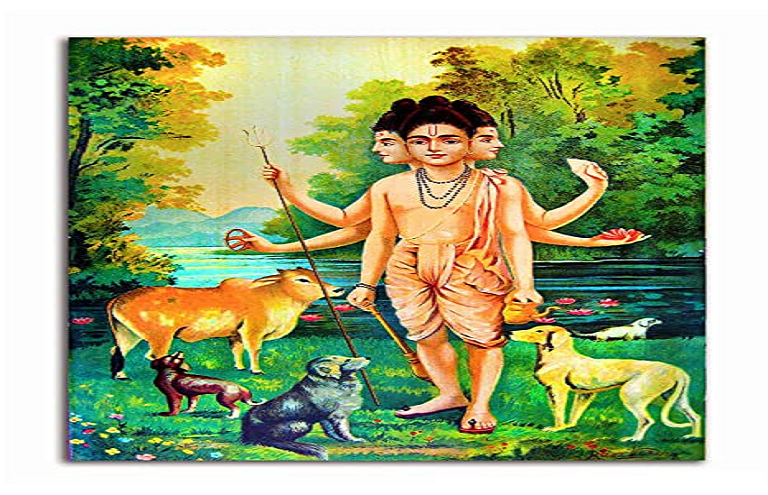
Final Words
Indeed, Raja Ravi Varma’s style of painting played a foundational role in defining Indian imagery and left behind a scintillating legacy of academic realism to cherish for a lifetime!
Don’t forget to share your views about this celebrated Indian painter in the comment section below.











